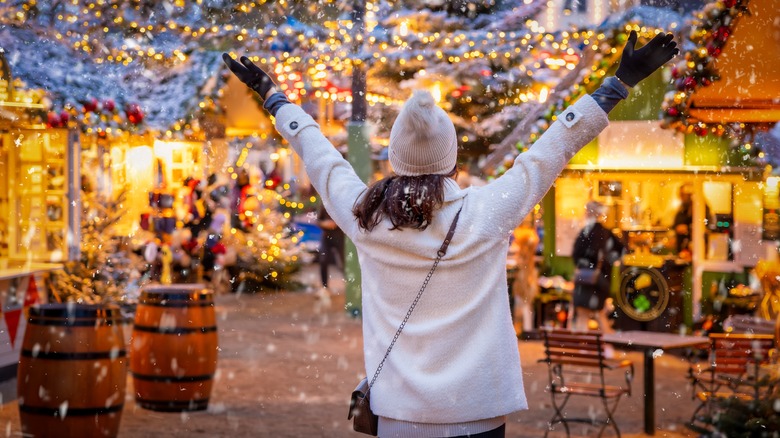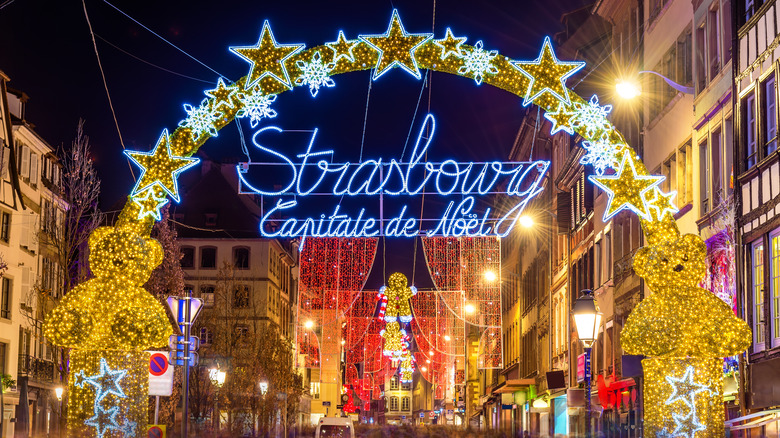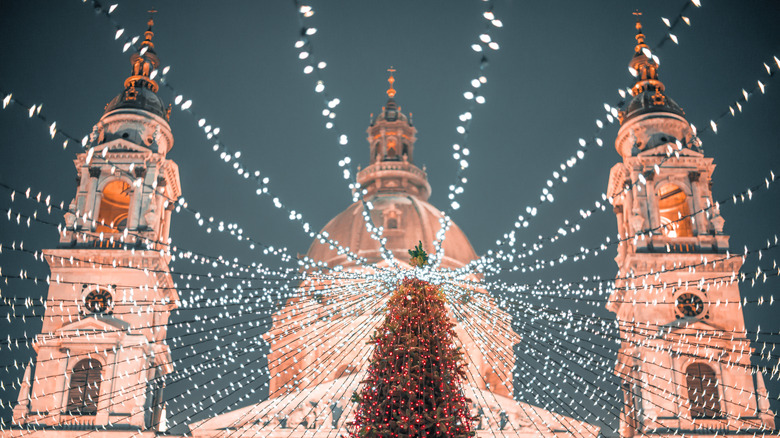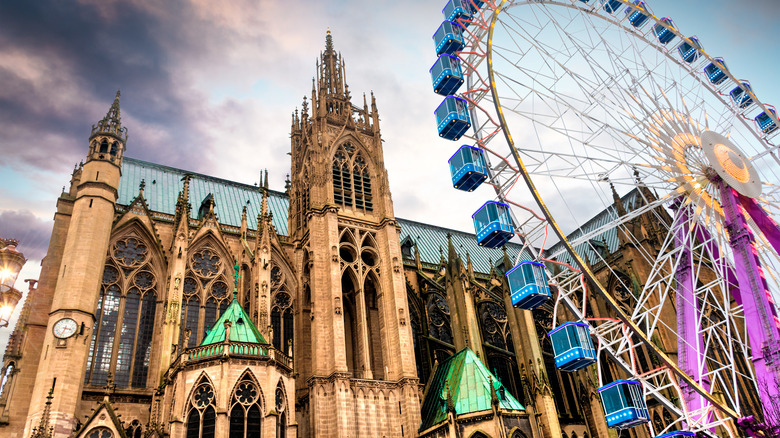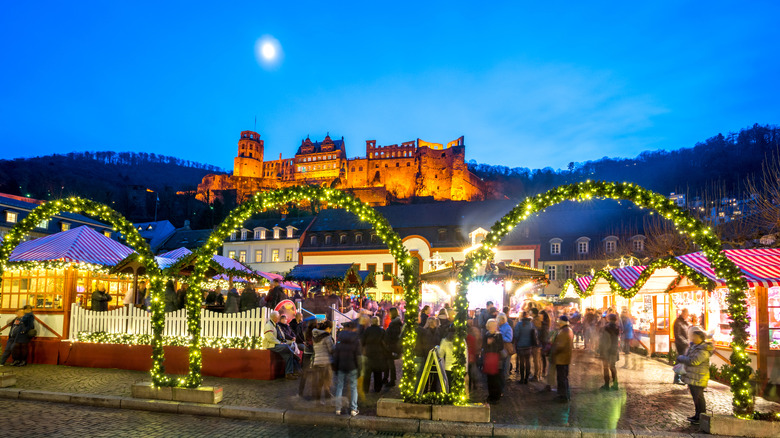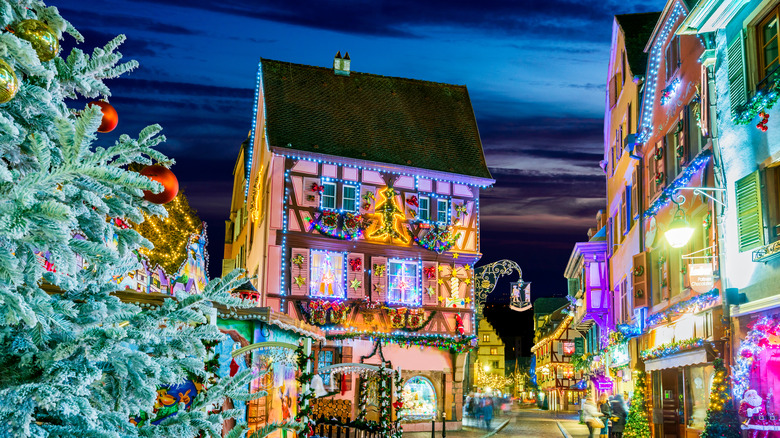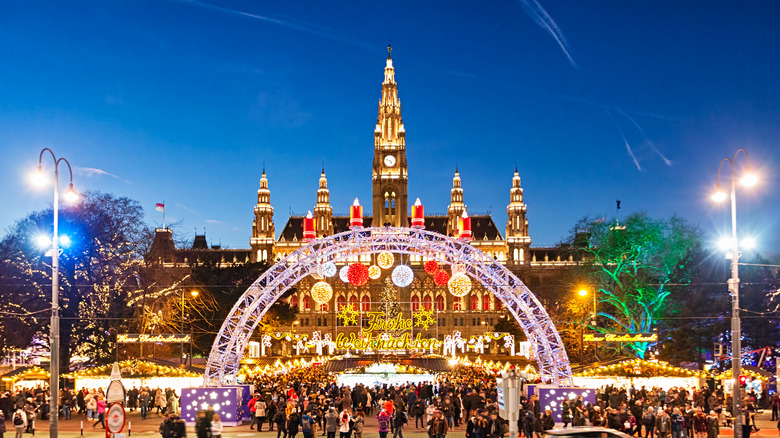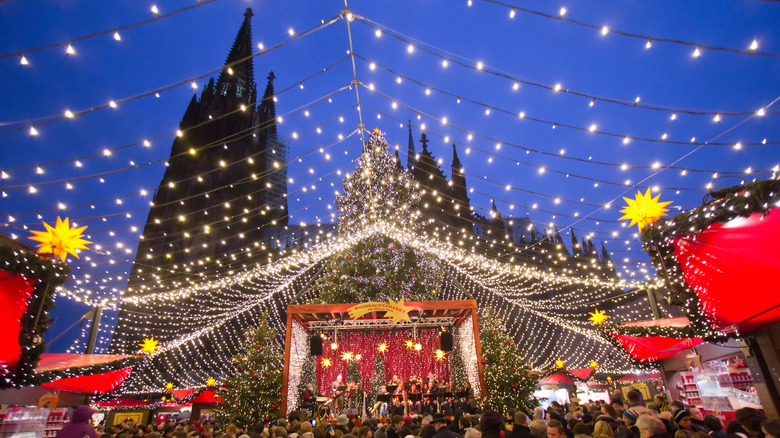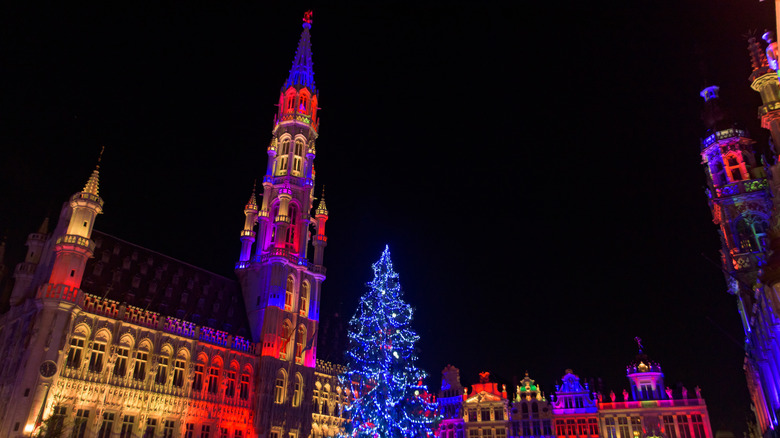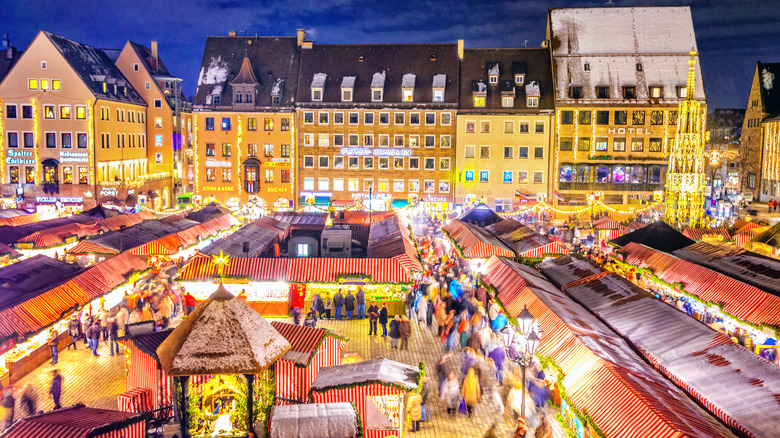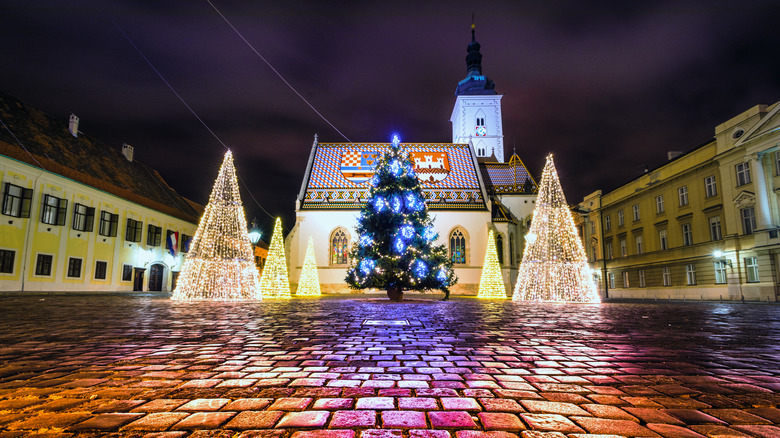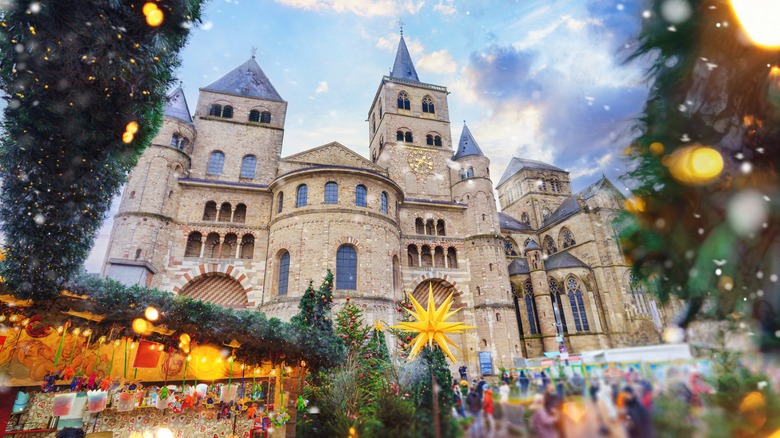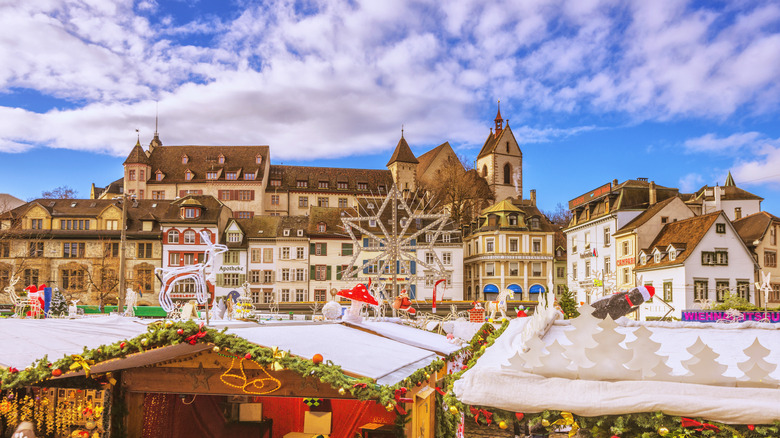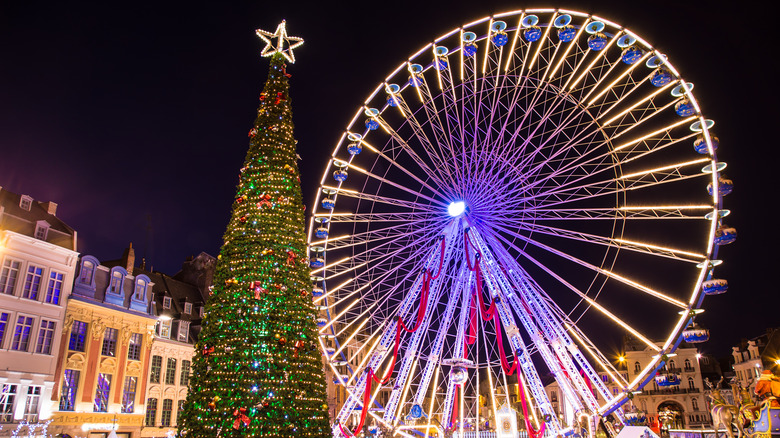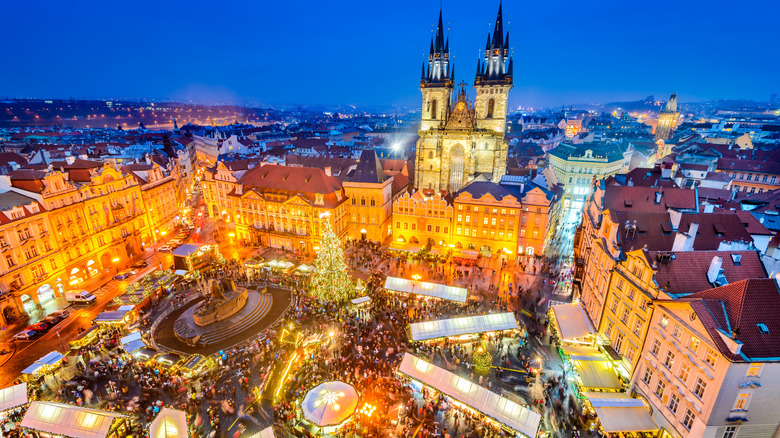European Cities With Incredible Christmas Markets You Should Visit, According To Visitors
The "most wonderful time of the year" is arguably the most magical period to plan a European trip. Why? Because it's the Christmas market season! The continent is full of incredible markets, from those in major cities to others in smaller towns that might have previously not been on your radar. The markets began in mainly German-speaking parts of Europe, so you'll see many of the largest and most popular in present-day Austria, Germany, and Switzerland. Initially, markets began just as December markets, some for Advent, but not strictly Christmas. A few cities claim the achievement of having the "oldest" markets in the world, including Dresden and Nuremberg, and while the phenomenon has definitely taken place for centuries in all those locations, there's no clear answer for which was first.
Over the years, they've evolved into a festive tradition where kids sample holiday treats, and adults sip mulled wine and shop for handmade local gifts. Even more recently, the idea of a "Christmas market trip" has become a bucket-list idea for many, but it can be difficult to decide which cities to include in your itinerary. Luckily, we've rounded up a collection of cities that are home to enchanting markets you won't want to miss. We've sourced our info from our writer's firsthand experiences, discussion forums, and Christmas-market expert bloggers, so rest assured, you're receiving the best info available.
Strasbourg, France
The city is nicknamed the "Christmas Capital of France" thanks to its reputation for stunning markets. Additionally, thanks to Strasbourg's location close to Germany, it has a unique atmosphere, culture, cuisine, and, of course, connection to Christmas traditions. Strasbourg has been passed back and forth between regional powers for hundreds of years, and it is a great place to experience a unique mélange of French and German traditions. The food is also reason enough to visit, with top-notch gingerbread, tarte flambeé (flammkuchen in German), and fantastic beer as delicious as you'll find in Bavaria served alongside Alsatian wine.
The ancient timber homes, colored like frosted Christmas cookies, and the looming cathedral (reminiscent of Paris' Notre Dame) provide a magical backdrop. Strasbourg has a few different festive markets spread throughout the town. However, the city center is walkable with plenty of pedestrian-only sections, which makes getting around relatively easy. You'll see classic Alsatian holiday characters around town, like Saint Nicholas, Hanns Trapp (like a Christmas boogeyman), and Christkindel (an angel), a fun sight for both children and adults. Markets here are open from the last week of November until Christmas Eve.
Budapest, Hungary
Budapest might not be as well-known by Americans looking to plan an epic Christmas market trip, but that just means you'll have fewer fellow tourists holding up the mulled wine queue! The Hungarian capital is a spectacular place to visit during the holidays. There are four different markets in Budapest, a city split by the Danube River whose two sides, Buda and Pest, were historically separate municipalities. Most sites and attractions are located on the "Pest" side, including the market in Vörösmarty Square, which is the largest in the city. If you only have time for one Christmas market in Budapest, make it this one, due to its ideal location and size, although it's so close to the one in front of St Stephen's Basilica that you should be able to do both easily.
On the Buda side, you'll find the Óbuda market, an easy walk across the river offering a more local feel. And if you're adventurous, take the train to Szentendre, a town north of the capital known to be arty and off-beat. The dates differ between markets, but they're usually open from mid-November through New Year's Day.
Metz, France
The Grand Est area of France is comprised of three former administrative regions, namely Alsace, Champagne-Ardenne, and Lorraine. The former, home to Strasbourg, is best known for its superb holiday atmospheres. However, Lorraine is special in its own right, and one of its largest cities is highly underrated, especially when it comes to festivities. The markets in Metz are among the biggest in France and sell a wide variety of local goodies, including Moselle wine and Mirabelle plum products.
The main markets can be found in Place d'Armes in the shadow of the beautiful cathedral, which you should make sure to visit as well. You'll also have the opportunity to ride a Ferris wheel and enjoy a vantage point over all of Metz, one that isn't possible outside the holiday season! At Place de la République is another market complete with a skating rink — a can't-miss in winter. Other markets are located at Place Saint-Jacques (highlighting local food and craft vendors) and Place Saint-Louis, a medieval part of the city that shimmers with festive light at night. The city is very compact, and all markets are within walking distance of each other.
Heidelberg, Germany
Just across the border from France is the German town of Heidelberg, an adorable location and one of Europe's top Christmas destinations. The vibe is noticeably more rustic here than in other big-city markets or more commercialized ones, and the coziness combined with the backdrop of a looming castle over the town makes you feel like you've stepped into a fairytale. The stalls are all built out of wood and can be found throughout most streets in the Alstadt, and the most logical starting point if you arrive by train or tram is Bismarckplatz. Then, stroll down to Anatomiegarten, where you can get personalized Christmas mugs.
Additional stalls can be found in Marktplatz and the Kornmarkt. The Kornmarkt has a winter forest with hundreds of Christmas trees that create a mystical atmosphere for sipping Glühwein, and everything culminates in a large square called Universitätsplatz. The best part? You can walk between all of these. The individual markets have varying open dates but can usually be found from late November until late December. Some stay open even a little past New Year's, and while there aren't any stalls at the castle, it's still a must-visit while in town and is particularly spectacular all dressed up for the holidays! It also offers gorgeous views over the town and lights.
Colmar, France
If you plan to visit Strasbourg, Metz, and Heidelburg, you need to make a detour to Colmar, known in traveler's circles as a "Mini Strasbourg," a truly adorable version of France's "Capital of Christmas." The brightly colored buildings and small canal known as "Petite Venice" feel like a child's holiday dream, especially if the sun makes an appearance and bathes everything in golden light.
Additionally, the town puts up a few different Christmas trees every year, a tradition which originates in Alsace. There's one in each market, which are actually all separate mini-Christmas villages dotted throughout the town. There is a gourmet village at Rue de la Montagne Verte, one situated around a fountain in the Old Town Square, light displays on stained glass at Place des Dominicains, a traditional Alsace village replica at Place Jeanne d'Arc, and much more. Colmar markets are typically open between late November and late December, and the small city is just a 30-minute train ride from Strasbourg.
Vienna, Austria
It's no surprise that a city as magical as Vienna has wonderful festive markets. And they're quite distinct from others thanks to having some of the largest diversity in available products, as well as themes from market to market. The stalls in Am Hof prioritize goods made by independent artists, while the Freyung market sells artisanal products and food from all over Austria. The market in front of City Hall is known as the "Viennese Dream" and provides one of the most fantastical backdrops on the continent. There's also a workshop on the first floor of the hall for kids who want to decorate cookies.
One of the most enjoyable parts of visiting Viennese Christmas markets is that the Glühwein isn't the same throughout the city. Typically, mulled wine at Christmas markets only comes in a flavor or two — red or white. Vienna takes it up a notch with various flavors on offer. Additionally, as is now widespread in the U.S., many festive pop-up bars appear throughout the city in December.
Cologne, Germany
Cologne has some of the largest markets in all of Europe, and like other destinations, there are quite a few sprinkled throughout the city. The main ones are in the Old Town, including Rudolfplatz, where you'll find the Village of Saint Nicholas, a cozy market where you can enjoy hot drinks of all kinds out of kooky "boot mug," a unique additional to any Christmas market mug collection. This is also where holiday performances take place.
In Neumarkt is the "Market of Angels," where a special atmosphere is created with thousands of fairy lights and sparkling stars. This market also houses stilted characters and angels, creating a fun environment for the whole family. These stalls primarily sell food, so head here when you start to feel peckish or need something to soak up your mulled wine. And, of course, you can't miss the stalls in the shadow of Cologne Cathedral, as well as those at the harbor; who doesn't love a waterside Christmas market? The Cologne festive markets are typically open between late November and December.
Brussels, Belgium
Belgium might not be as well-known for its holiday markets as neighboring France and Germany, but its capital city has some fabulous options. And who could pass up the chance to enjoy Belgian chocolate, beer, fries, and waffles?! The market in the Grand-Place comes complete with ornate gold-laced buildings and a fantastic Christmas tree as backdrops. And a wonderful light show set to music goes off once a day, twice on weekends, so be sure not to miss it! The old fish market nearby also hosts a great array of stalls as well as a giant wheel that offers magnificent views of the entire city.
La Tour Noire is where you'll find international gifts and treats, should you want to sample goodies from around the world. La Bourse (or the old Brussels Stock Exchange) hosts some of the city's finest artisans, so if you want to purchase high-quality gifts for loved ones, this would be the place to do it. Place de Brouckère has a real party atmosphere with little terraces where you can put up your feet after a long day of browsing markets, making it the perfect place to finish up. Markets in Brussels open in late November and stay open through late December.
Nuremberg, Germany
One of the largest and oldest markets in Europe, with a tradition dating back to the 1500s, Nuremberg is a favorite throughout Germany. Located in Bavaria, the historic center of Christmas tales and cheer, the buildings are reminiscent of gingerbread structures, and the international parts of the market are delightfully varied. Kids dressed up as angels and other Christmas-themed characters frequently walk around and hand out cookies, so keep your eyes peeled.
Additionally, a fun thing about visiting Nuremberg during the holiday season is that it has more than just markets to explore. Every year, you can find many concerts and exhibitions on the history of Christmas throughout town. There's even a decent-sized toy museum, which will delight children and parents alike! Finally, make sure you hike up to the castle for great views of the city and lights. It's best to do it at sunset, to catch the colors, and then enjoy panoramas of the lit-up holiday decorations. Nuremberg markets are usually only open during December.
Zagreb, Croatia
Zagreb is a not-oft thought-of holiday destination, let alone for Christmas markets, as most trips to Croatia take place during the summer months. However, the capital has award-winning markets celebrated by bloggers and visitors that are easy to wander around thanks to the walkability of the city. In fact, there are over 25 individual markets in Zagreb, but its compact layout and smaller size mean they blend together for a fantastic atmosphere full of holiday cheer.
Many stalls sell handcrafted wood figurines, an artisan specialty from the north of Croatia. The heart-shaped gingerbread sold all over the city is a national symbol that may have originated as a treat but is now primarily used for decorative purposes. If you're a fan of skating, you'll find a rink at King Tomislav Square. And in the Grič Tunnel, imaginative holiday installations are put up every year. And for more fun, while you're walking the streets, enjoy decorated public transportation and concerts on numerous balconies throughout the city center. Zagreb markets are open from early December through the first week of January.
Trier, Germany
Trier is a former Roman stronghold located along the Moselle River between rolling green hills. Despite the picturesque setting, it often flies under the travel radar. But if you're traveling during the holidays, make sure to stop by as it transforms into a real-life Christmas wonderland! The locations in two separate squares make the festive cheer walkable amongst the Roman ruins. The two main squares in town are named Hauptmarkt and Domfreihof, where most stalls are set up. The cathedral in the latter is free to enter, a fascinating experience as it feels more like a castle than a church.
In addition to the ruins surrounding the city, you'll also find an amazing mix of architecture all around, from Baroque to Gothic and Romanesque. It all makes for a gorgeous setting that feels like you're in a real-life gingerbread village. Trier is easily accessible via direct train from nearby Luxembourg City and Koblenz. The markets are open from late November to just a few days before Christmas.
Basel, Switzerland
Basel isn't always included on Swiss trips or Christmas market itineraries, which means fewer travelers — always a bonus. However, this charming destination along the Rhine makes for a magical stop for mulled wine and fondu in a location that is a mélange of French, German, and Swiss culture and tradition. The classic mulled wine found at every Christmas market is sold throughout the stalls, as well as bratwurst, French and Swiss cheese, and unique creations like a fondu-filled baguette.
The two main markets are the ones in Barfüsserplatz and Münsterplatz. The former is a bit smaller but is centrally located near public transportation and has a huge variety of goods for sale. The stalls in Münsterplatz, home to the iconic Minster (a feast for the eyes amongst the craziness of markets), are a bit larger. It also hosts a fairytale forest with lots of games and activities for little ones. If you have time, climb the cathedral for amazing views of the city and lights. The Basel City Market is more low-key, with the town hall as a backdrop, and they are open from late November to just before Christmas Eve.
Lille, France
In the north of France and not far from the Belgian border, the unique city of Lille is home to awesome Christmas markets. The unique architecture of the city provides a unique backdrop for the markets, especially compared to others in France. The colorful buildings that used to be Flemish merchant houses are the perfect setting for holiday cheer. The cafes and bars in Lille are also always beautifully decorated and have music playing, which provides a nice soundtrack to browse the stalls.
There's a large wheel in the central city square that offers fantastic views of the city. Additionally, kids can have their picture taken with Santa and pass on their wishlists at Santa's cottage, which is open during market hours. It is also a great holiday destination that pairs well with Brussels, just a 35-minute train ride away. Lille has markets available from around Thanksgiving through the end of December.
Prague, Czech Republic
Prague is well placed on the continent to be a convenient holiday stop between Vienna and Dresden, two of the most popular market towns in Europe. However, give yourself at least a day to enjoy those in Prague, as you'll regret it if you don't. The Czech capital is dressed to the nines in holiday decor every year, and if you're lucky, you'll catch it on a snow day, the picture-perfect setting to enjoy Christmas markets!
The main ones are located in Old Town Square (where the giant Christmas tree is placed each year) and Wenceslas Square, although the latter is more of a boulevard than a plaza. The two markets are a quick walk from each other, thanks to the high walkability of Prague's city center. Smaller options, such as those in Republic Square, Peace Square, or even Prague Castle, are also worth visiting and often have more charm and fewer tourists. At all markets, amazing Czech delicacies can be purchased and enjoyed, from a national version of mulled wine to hot mead and local sweet favorite — trdelnik, a cylinder cake filled with your choice of custard, fruit, or other treats! Okay, the trdelnik isn't exactly a traditional Czech treat, but it is delicious all the same. Markets in Prague open in early December, with many sticking around through the first week in January.
